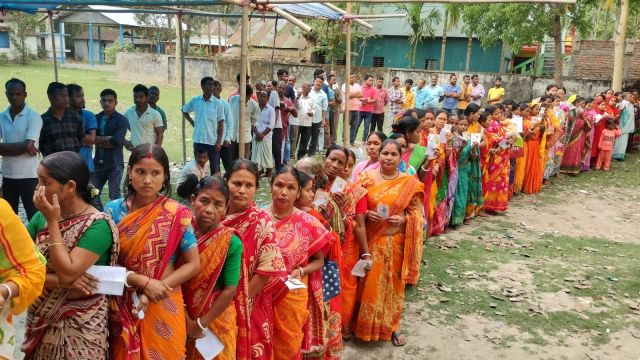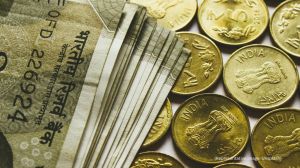Turnout down by 4 per cent points in Phase 1 over 2019, EC looks at ways to bring more voters out
Across the states, polling officers that The Indian Express spoke to offered different reasons to explain the dip in turnout – from the intense heat to a busy wedding season to a lack of enthusiasm.
 The West Bengal (3 seats) CEO’s said the dip could possibly be attributed to a “heatwave and an increase in temperature, which is unusual for the northern part of West Bengal”. (Express photo by Partha Paul)
The West Bengal (3 seats) CEO’s said the dip could possibly be attributed to a “heatwave and an increase in temperature, which is unusual for the northern part of West Bengal”. (Express photo by Partha Paul)Voting for the 18th Lok Sabha commenced on a relatively tepid note with the first and largest phase of the seven-phase elections showing a decrease of about 4 percentage points in voter turnout, a development that has officials of the Election Commission of India concerned.
On Friday, the 102 seats that were up for election, with a little over 16 crore voters eligible to cast their votes, saw a turnout of approximately 65.5%, a decline from the 70% recorded in 2019. While the Election Commission was yet to release the final turnout figures, as per the EC’s Voter Turnout app at 7pm on Saturday, turnout had decreased in 19 out of the 21 states and Union Territories in the first phase.
With this, 10 states and Union Territories, including Tamil Nadu and Uttarakhand, have completed their polling.
Tamil Nadu, with its 39 seats, saw its voting percentage decline by roughly 3 percentage points, from 72.44% to 69.46%. Uttarakhand, with five seats, witnessed a dip of almost six percentage points, from 61.88% to 55.89%. Rajasthan, which had 12 of its 25 seats go to polls on Friday, experienced a decrease in turnout by over six percentage points – from 64% to 57.65%. The only seat in Chhattisgarh that went to polls on Friday, Bastar, saw turnout increase a little over 1% from 66.26% to 67.53%. For the first time, polling was held in 56 villages of Bastar that had been affected by Left Wing Extremism. Turnout in Meghalaya’s two seats also increased, from 71% to 74%.
The first phase of voting in Lok Sabha elections usually sets the tone for subsequent phases, as data from the last two parliamentary elections – also held in April and May – shows. For instance, in 2019, phase 1 recorded the highest turnout, at 69.5%, in the seven-phase elections. Similarly, the first phase of the nine-phase 2014 parliamentary polls was among the highest, at around 69%. It is this pattern that has officers at Nirvachan Sadan concerned.
The Commission had, on its part, gone all out to encourage voter participation – from roping in more than 10 celebrities as ambassadors to teaming up with the BCCI to spread awareness among IPL audiences to ensuring booths were voter-ready. “We have left no stone unturned. Despite all that, we have witnessed a dip. It’s not an alarming decrease, but a dip nevertheless,” a senior EC official said.
According to sources, barring roughly 10 seats out of 102, almost all have witnessed a decrease in turnout. EC estimates show an overall decline of four percentage points in the first phase turnout would mean that approximately 48 lakh enrolled voters, compared to last time, did not turn up to vote.
“It’s difficult to say which age group did not turn up in large numbers; otherwise, it would have been easier for us to target them in the subsequent phases to encourage them to vote,” the officer said.
“With temperatures expected to rise further in the coming days, this presents a significant challenge ahead for the EC,” the officer acknowledged. “We haven’t decided yet how to respond to this, but we will have to figure out a way to encourage voters to come out in the subsequent phases.”
Across the states, polling officers that The Indian Express spoke to offered different reasons to explain the dip in turnout – from the intense heat to a busy wedding season to a lack of enthusiasm. However, they cautioned that they are still in the midst of assessing how much these factors contributed.
In Tamil Nadu – the state with the highest number of seats (39) in phase 1 – political leaders from the DMK, AIADMK, and BJP attributed the subdued voter turnout to two factors: the extreme temperatures and a lack of enthusiasm due to the election being a three-cornered contest, which left only a few seats hotly contested. According to latest estimates from the DMK, AIADMK and BJP, about eight of the 39 seats in Tamil Nadu are expected to witness tight races.
The urban region of Chennai continued its pattern of lower voter participation, with Chennai Central recording a 53.9% turnout. This urban voter apathy is in stark contrast to rural areas like Dharmapuri, which led with an impressive 81.5%, although this too was a slight decrease from its 2019 turnout of 82.41%.
The constituencies with the highest voter turnout were Dharmapuri, Kallakurichi (79.25%), Karur (78.6%), Namakkal (78.2%), and Salem (78.1%). In contrast, the lowest turnouts were in Chennai Central (53.9%), Chennai South (54.3%), Tuticorin (60%), and Chennai North (60.1%).
Three constituencies countered the overall downward trend, experiencing an increase in voter turnout. Kallakurichi saw a modest increase from 78.77% to 79.25%, while Arani increased from 78.94% to 79.65%, and Villupuram from 74.56% to 76.47%.
Notable decrease in voter turnout was observed in several areas. Thoothukudi, for example, had a substantial drop from 69.43% to 59.96%. Similarly, Chennai Central fell from 58.95% to 53.91%, and Chennai South from 57.05% to 54.27%.
In Uttarakhand, Chief Electoral Officer, BVR Purushottam, told The Indian Express that the final figures could rise. “As of Friday’s conclusion, the voting percentage stood at 55.89 percent. We are still tabulating the final numbers, expected to be concluded by Saturday end. With the inclusion of postal ballots, we project the figure to near 58 percent,” he said.
Asked about the potential reasons for the decline, he pointed out factors such as the current wedding season and a harsh sun during the day.
“We anticipate a roughly 3 percent decrease compared to the last general elections when factoring in postal ballots, which isn’t notably significant. Various factors contribute to voter participation… One of the main reasons is that this is a major wedding season and there were so many weddings in the state on April 18. Because of this, we even had to let go of 160 buses hired by us as they were pre-booked for weddings. In the plain areas, harsh sunlight was another reason. In the morning, we had good voting, but we later noticed a significant dip in the afternoon,” Purushottam said.
In Madhya Pradesh (6 seats), EC officials said they are assessing the reasons for the low turnout despite an almost year-long exercise to raise voter awareness since the assembly elections last year.
“In the Assembly elections, voter turnout was high. In panchayat polls, it even reaches 95 percent. In this phase, some districts have seen lesser turnout and we are trying to analyse the reasons. So far, reasons like the summer and the wedding season in the state have come to the fore,” a senior state EC official said. “But summer is not the sole factor. There may be other factors as well. Last time too, polls took place during summer months.”
In Bihar (4 seats), Chief Electoral Officer H R Srinivas told The Indian Express, “We cannot narrow it down to one factor. There could be some latent reasons. Heatwave is one clear reason. There could also be a general lack of enthusiasm among voters.”
In Assam (5 seats), there is a dip of 2.38 percentage points, with the latest data on Friday’s turnout at 75.95%. However, a senior election officer in the state said it was too early to comment if there has been a notable dip in comparison to 2019.
The CEO of West Bengal (3 seats) said the dip could possibly be attributed to a “heatwave and an increase in temperature, which is unusual for the northern part of West Bengal”.







